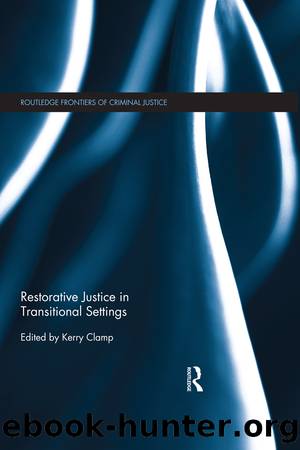Restorative Justice in Transitional Settings by Kerry Clamp

Author:Kerry Clamp [Clamp, Kerry]
Language: eng
Format: epub
ISBN: 9780367597092
Google: 1CqTzQEACAAJ
Publisher: Taylor & Francis Group
Published: 2020-06-30T02:52:29+00:00
All these functions have restorative dimensions, but of particular importance here is the value of providing a measure of process control to proceedings, reflected mostly in points four and five. By providing an officially recognised space, controlled by community members rather than elites, this can be achieved. This is especially true if the boards are considered genuine partners with institutions such as the ICC and ECCC and have some level of oversight of these institutions.
Boards would ideally be empowered to discuss and provide comment on the process of justice initiatives, including official institutions, allowing a measure of oversight that would constitute a more practical level of process control than direct control of legal proceedings. It has previously been observed that âtransitional justice could benefit from greater accountabilityâ (Nickson 2013: 383) and boards could provide and promote that accountability through oversight, monitoring and by providing a space where unencumbered conversations can take place about the shortcomings of official responses and where feedback can be provided to the institutions themselves. Oversight and an opportunity to comment on the operation of institutions could constitute a meaningful form of process control for victims and wider community members. Done well, boards of this sort can act to enhance the restorative endeavours and complement the retributive efforts of courts. When there are procedural limits on how victims can participate in specific legal proceedings, this role could broaden participation and deepen involvement â two developments that are central to enhancing the justice citizens can receive in transition (Nickson and Braithwaite 2014).
Forums, such as boards modelled on peace committees, could also provide a measure of process control for victims and wider members of affected communities, particularly if entrusted with taking the partial restorative work of courts and building additional restorative activities from this foundation. This can also help to build links with efforts that have cultural resonance for the society in transition. This type of collaboration has been done well in Cambodia, where links between the ECCC and civil society groups have aided in broadening the justice that is provided to Cambodians, and included additional restorative practices within communities (Nickson 2013). If this collaboration were devolved to victims and other community members through representative boards, in addition to or instead of court staff and leadership of international NGOs, it could further empower victims. As the Rwandan gacaca experience has demonstrated, even in communities where widespread atrocities have taken place, there is an available cohort of suitable community members who can aid in steering restorative efforts to the wider benefit of victims and communities. It also provides scope for infusing a more culturally relevant dimension to activities. For example, boards can undertake or promote the sorts of spiritual activities that might be contextually appropriate for societies in transition, but that the ICC is unable to address in The Hague. These might be, for instance, the reconciliation ceremonies conducted in Timor Leste that addressed the spiritual needs of communities and the essential features that held those societies together (Braithwaite et al.
Download
This site does not store any files on its server. We only index and link to content provided by other sites. Please contact the content providers to delete copyright contents if any and email us, we'll remove relevant links or contents immediately.
Russia's Sakhalin Penal Colony, 1849â1917 by Andrew A. Gentes(176)
A History of Police and Masculinities, 1700-2010 by David G. Barrie Susan Broomhall(128)
Introduction to Criminal Justice - A Balanced Approach by Brian K. Payne Willard M. Oliver Nancy E. Marion(124)
Serial Killers America and UK - 2 BOOKS IN 1 by Clark Matthew(108)
Policing Gender, Class And Family In Britain, 1800-1945 by Linda Mahood(96)
Cops, Cameras, and Crisis by Michael D. White Aili Malm(91)
Restorative Justice in Transitional Settings by Kerry Clamp(88)
Dangerousness, Risk and the Governance of Serious Sexual and Violent Offenders by Karen Harrison(88)
Organized Crime and Corruption Across Borders by T. Wing Lo Dina Siegel Sharon I Kwok(85)
A Theory of African American Offending by James D. Unnever Shaun L. Gabbidon(82)
Losing Legitimacy by Gary Lafree(79)
The Real CSI by Kate Bendelow(77)
The 1921 Tulsa Race Massacre by Chris M. Messer(74)
Women Exiting Prison by Bree Carlton Marie Segrave(73)
Routledge Handbook on Immigration and Crime by Holly Ventura Miller Anthony Peguero(73)
Forensic Criminology by Andy Williams(73)
Broadmoor--My Journey Into Hell by Charlie Bronson(72)
Police Detectives in History, 1750â1950 by Clive Emsley Haia Shpayer-Makov(72)
Using Murder by Philip Jenkins(67)
